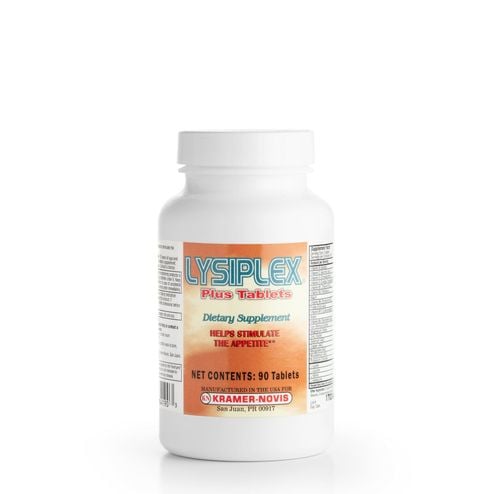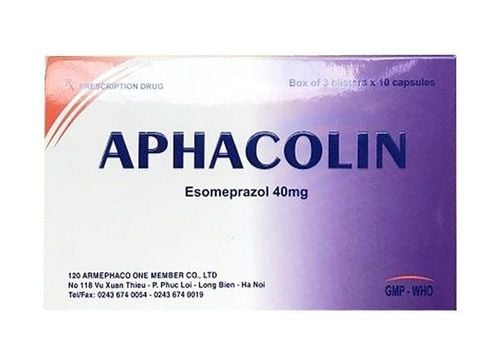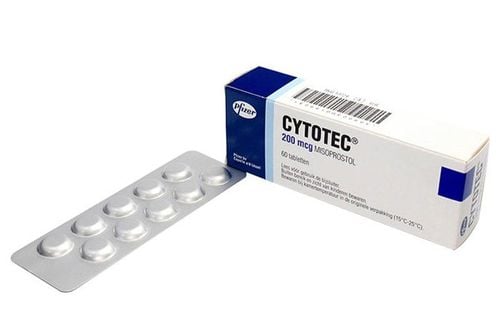This is an automatically translated article.
Esoragim 20 is a gastrointestinal drug manufactured by the branch of Agimexpharm Pharmaceutical Joint Stock Company - VIETNAM. Esoragim 20 contains Esomeprazole and is packaged as enteric-coated film-coated tablets.
1. Ingredients of Esoragim 20
Esoragim 20 has the main ingredient Esomeprazole (in the form of esomeprazole magnesium trihydrate), this is a 20 mg proton pump inhibitor, which is made into enteric film-coated tablets. Esomeprazole is the S-isomer of Omeprazole that reduces gastric acid secretion by a specific mechanism of action that specifically inhibits the acid pump in parietal cells. Esomeprazole is a weak alkaline substance that is concentrated and converted to the active form in the highly acidic environment of the tubules, where it inhibits the enzyme H+K+-ATPase and inhibits both basal and exudative secretion. due to stimulation.
After 5 days of oral administration of Esomeprazole 20 mg and 40 mg, gastric pH > 4 was maintained for a mean of 13 and 17 hours, respectively, in patients with symptomatic GERD. This effect is the same regardless of whether Esomeprazole is administered orally or intravenously.
It has been shown that there is a relationship between inhibition of acid secretion and drug exposure and duration of exposure after oral administration of Esomeprazole. After taking Esomeprazole 40 mg orally, approximately 78% of patients with reflux esophagitis were healed after 4 weeks, and 93% of patients were healed after 8 weeks.
During treatment with antisecretory drugs, serum gastrin levels will increase in response to a decrease in gastric acid. Increased ELC cell counts due to increased serum gastrin levels have been observed in some patients during long-term treatment with oral esomeprazole. Following long-term treatment with anti-secretory drugs, gastric cysts have been reported to occur relatively frequently, as a physiological result of a strong inhibition of gastric acid secretion, a condition similar to that of gastric acid secretion. benign and reversible.
2. What is the effect of Esoragim?
In adults, Esoragim 20 is indicated for the following cases:
Gastroesophageal reflux disease (GERD), treatment of erosive reflux esophagitis, long-term treatment of patients with healed esophagitis to prevent recurrence; Esoragim 20 in combination with an appropriate antibacterial regimen for eradication of Helicobacter pylori, healing of duodenal ulcers caused by Helicobacter pylori infection, and prevention of recurrence of peptic ulcers in patients with Helicobacter pylori ulcers. Prevention of NSAID-induced gastric and duodenal ulcers in patients at risk; Prolonged treatment after treatment and prevention of peptic ulcer rebleeding with intravenous drugs; Zollinger Ellison syndrome. In adolescents aged 12 years and older, Esoragim 20 is indicated for the following cases:
Gastroesophageal reflux disease (GERD), treatment of erosive reflux esophagitis, long-term treatment of patients with esophagitis. healed management to prevent recurrence; In combination with antibiotics in the treatment of duodenal ulcers caused by Helicobacter pylori. Adhere to using Esoragim 20 exactly as directed on the drug instruction sheet or doctor's prescription sheet.
Contraindicated to use Esoragim 20 drug for people with a history of hypersensitivity to Esomeprazole, benzimidazole subgroup or other ingredients in the formulation of Esoragim 20. Cases of contraindications specified in the instruction sheet for use of Esoragim 20 or a doctor's prescription are absolute contraindications, not for any reason, but contraindications are flexible to use Esoragim 20.
3. Dosage and how to use Esoragim 20
Duodenal ulcer use Esomeprazole 20 mg/day for 2 - 4 weeks; Gastric ulcer and reflux esophagitis use Esomeprazole 20mg/day for 4-8 weeks; Esomeprazole dose may be increased to 40 mg/day in patients resistant to other therapies; Zollinger-Ellison syndrome use Esomeprazole 60 mg/day; Prophylaxis of recurrence of gastric and duodenal ulcers caused by the use of NSAID anti-inflammatory drugs using esomeprazole dose of 20-40mg/day.
4. Possible drug interactions when using Esoragim 20
Esomeprazole in Esoragim 20 can inhibit CYP2C19 - the main enzyme that metabolizes Esomeprazole. Therefore, when Esoragim 20 is co-administered with drugs metabolised by CYP2C29 such as Diazepam, Citalopam, Imipram, Imipramine, Clomipramine, Phenytoin... the plasma concentrations of these drugs may increase and it is necessary to consider reducing them. dosage.
5. Side effects of Esoragim 20
The following Esoragim 20 adverse reactions have been reported or suspected in clinical studies of Esomeprazole, however none of them are dose related.
Common side effects of Esoragim 20 : Headache, abdominal pain, diarrhea, flatulence, nausea/vomiting, constipation. Less common side effects of Esoragim 20: Dermatitis, itching, hives, dizziness, dry mouth. Rare side effects of Esoragim 20: Hypersensitivity reactions such as angioedema, anaphylactic reactions, increased liver enzymes. Other possible adverse reactions with Esomeprazole:
Central and peripheral nervous system: Paresthesia, somnolence, insomnia, dizziness, reversible confusion, agitation, agitation, depression, illusion. Endocrine system: gynecomastia; Digestive system: stomatitis, gastrointestinal candidiasis; Hematology: leukopenia , thrombocytopenia, agranulocytosis, decreased total blood cells; These are not all the side effects of this drug. Therefore, during the use of the drug, if you experience any unusual symptoms, you should inform your doctor.
Please dial HOTLINE for more information or register for an appointment HERE. Download MyVinmec app to make appointments faster and to manage your bookings easily.













